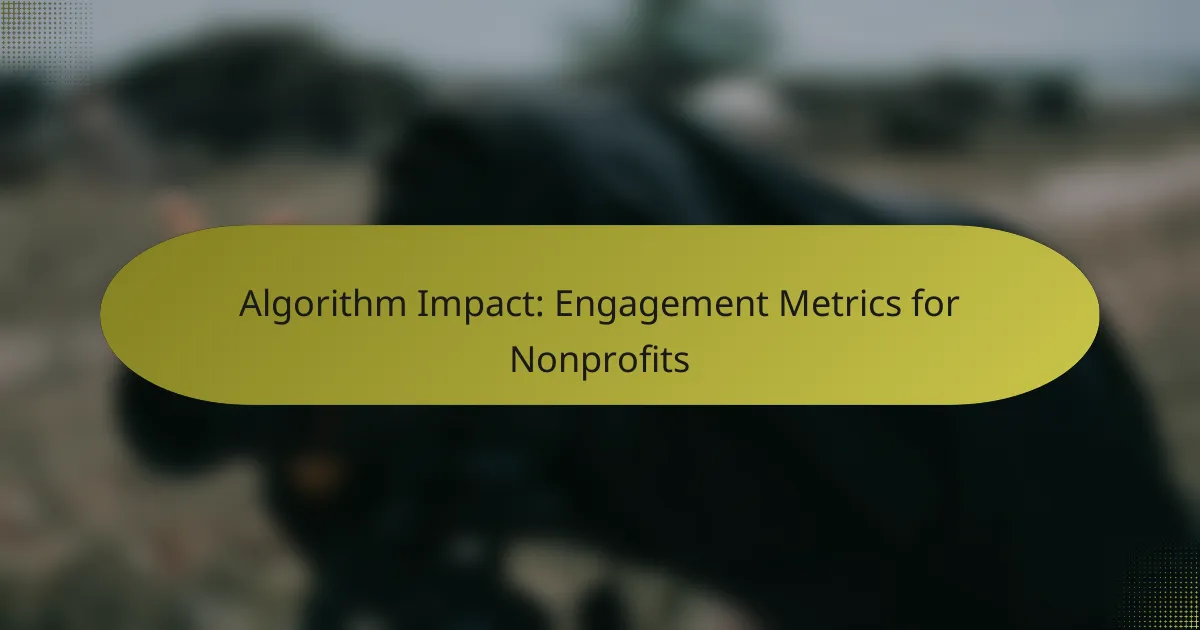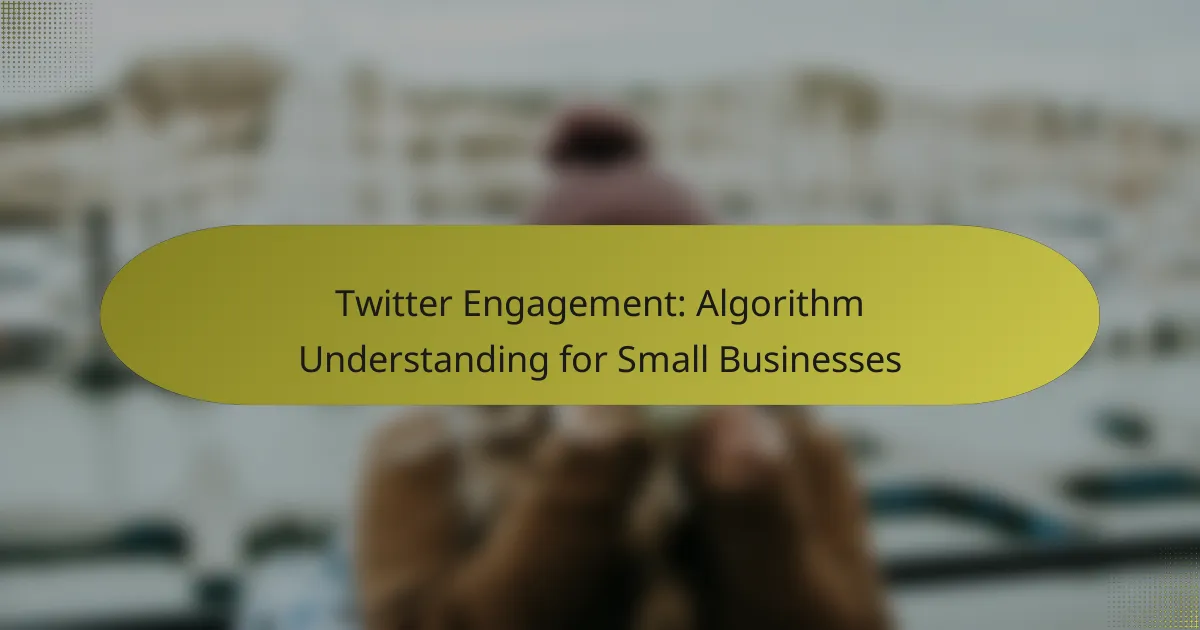Nonprofits can significantly improve their engagement metrics by utilizing data-driven strategies that resonate with their target audience. By focusing on areas such as social media, email campaigns, and storytelling, organizations can enhance their outreach efforts and foster deeper connections with supporters. Understanding the impact of algorithms on content visibility is crucial for maximizing interaction and achieving organizational goals.
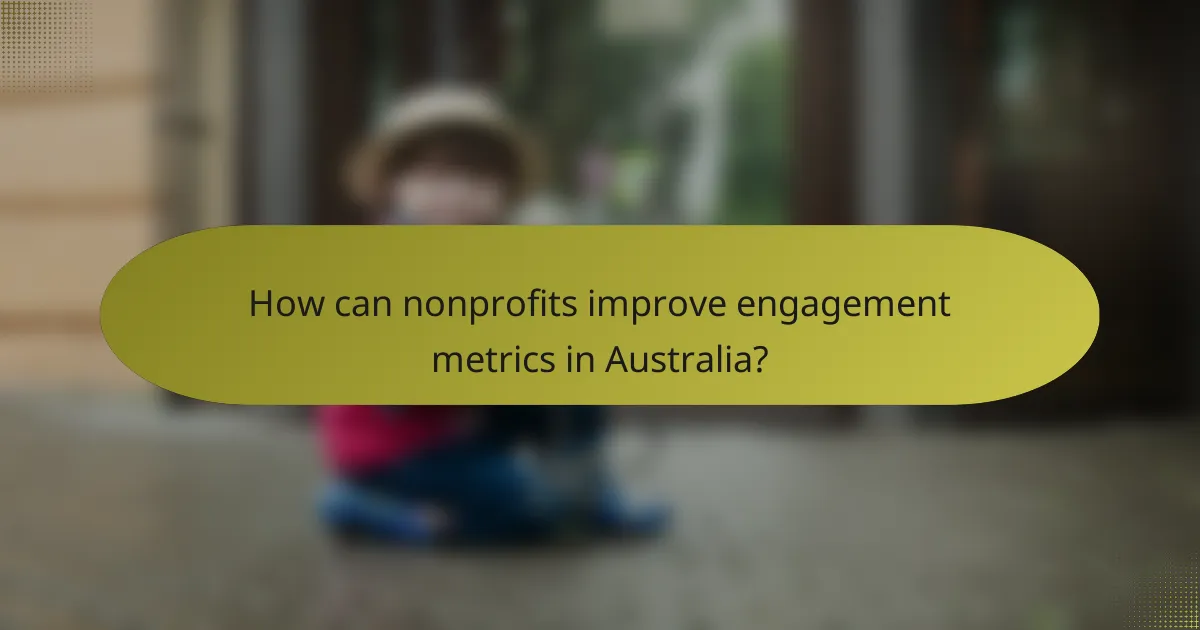
How can nonprofits improve engagement metrics in Australia?
Nonprofits in Australia can enhance engagement metrics by leveraging data-driven strategies tailored to their audience. Focusing on social media, email campaigns, community outreach, website optimization, and storytelling can significantly boost interaction and support.
Utilize social media analytics tools
Social media analytics tools provide insights into audience behavior, preferences, and engagement patterns. By using platforms like Facebook Insights or Instagram Analytics, nonprofits can track which posts resonate most with their followers and adjust their content strategy accordingly.
Regularly reviewing these metrics helps identify peak engagement times and popular content types, allowing for more effective scheduling and targeted messaging. Aim to analyze data at least monthly to stay responsive to audience trends.
Implement targeted email campaigns
Targeted email campaigns can significantly increase engagement by delivering personalized content to specific segments of your audience. Use tools like Mailchimp or Campaign Monitor to segment your email list based on donor history, interests, or demographics.
Craft compelling subject lines and tailor the content to each group’s preferences. A/B testing different approaches can help refine your messaging for better open and click-through rates. Aim for a frequency that maintains interest without overwhelming recipients, typically once or twice a month.
Leverage community events for outreach
Community events are an effective way to engage with local supporters and raise awareness about your cause. Hosting events such as workshops, fundraisers, or volunteer days can foster a sense of community and encourage participation.
Promote these events through social media and email to maximize attendance. Consider collaborating with local businesses or other nonprofits to broaden your reach and resources, making events more impactful and enjoyable for participants.
Optimize website for user experience
A well-optimized website enhances user experience and keeps visitors engaged. Ensure your site is mobile-friendly, loads quickly, and has clear navigation to help users find information easily.
Incorporate calls-to-action (CTAs) that guide visitors towards desired actions, such as donating or signing up for newsletters. Regularly update content to keep it relevant and engaging, and consider using tools like Google Analytics to monitor user behavior and make necessary adjustments.
Engage with storytelling techniques
Storytelling can create emotional connections with your audience, making your cause more relatable and compelling. Share stories of individuals or communities impacted by your work to illustrate the importance of your mission.
Use various formats, such as videos, blog posts, or social media stories, to reach different audience segments. Highlighting real-life experiences can motivate supporters to engage, donate, or volunteer, ultimately enhancing your overall engagement metrics.

What are key engagement metrics for nonprofits?
Key engagement metrics for nonprofits include various indicators that help assess the effectiveness of outreach efforts. These metrics provide insights into how well a nonprofit is connecting with its audience and achieving its goals.
Conversion rates from campaigns
Conversion rates measure the percentage of individuals who take a desired action after engaging with a campaign, such as donating or signing up for a newsletter. A typical conversion rate for nonprofits can range from 1% to 5%, depending on the campaign’s effectiveness and audience targeting.
To improve conversion rates, nonprofits should focus on clear calls to action and compelling messaging. A/B testing different approaches can help identify what resonates best with the audience.
Social media interaction rates
Social media interaction rates reflect the level of engagement a nonprofit receives on platforms like Facebook, Twitter, and Instagram. This includes likes, shares, comments, and overall reach. A good interaction rate typically falls between 1% and 3% of total followers.
To enhance interaction rates, nonprofits should post regularly, use engaging visuals, and encourage audience participation through questions or polls. Monitoring analytics can help refine strategies based on what content performs best.
Email open and click-through rates
Email open rates indicate the percentage of recipients who open an email, while click-through rates measure how many clicked on links within that email. Average open rates for nonprofits hover around 20% to 30%, and click-through rates can range from 2% to 5%.
To boost these rates, nonprofits should segment their email lists and personalize content. Crafting compelling subject lines and ensuring mobile-friendly designs can also significantly improve engagement.
Event attendance and participation
Event attendance and participation metrics track how many individuals attend or engage in nonprofit events, whether in-person or virtual. Successful events often see attendance rates of 50% to 75% of those who registered.
To maximize attendance, nonprofits should promote events well in advance and provide clear information on the benefits of participation. Offering incentives, such as early-bird pricing or exclusive content, can also encourage higher turnout rates.

How does algorithm impact engagement metrics?
The impact of algorithms on engagement metrics is significant, as they determine how content is prioritized and displayed to users. For nonprofits, understanding these algorithms can enhance visibility and interaction with their audience.
Changes in social media algorithms
Social media platforms frequently update their algorithms, affecting how content is shown to users. These changes can lead to fluctuations in engagement metrics, as posts may receive less visibility if they don’t meet new criteria. Nonprofits should stay informed about these updates to adjust their strategies accordingly.
For example, platforms like Facebook and Instagram may prioritize content that generates comments and shares over simple likes. Nonprofits can encourage interaction by asking questions or creating shareable content, which can improve their reach.
Search engine ranking factors
Search engines use complex algorithms to rank content, which directly influences engagement metrics such as click-through rates. Factors like keyword relevance, site speed, and mobile-friendliness play a crucial role in determining how well a nonprofit’s website performs in search results.
To enhance search engine visibility, nonprofits should focus on optimizing their content with relevant keywords, ensuring fast loading times, and providing a seamless mobile experience. Regularly updating content can also help maintain higher rankings.
Content visibility on platforms
The visibility of content on various platforms is largely dictated by algorithms that assess user engagement and relevance. High-quality, engaging content is more likely to be promoted, while poorly performing posts may be buried in feeds.
Nonprofits should analyze which types of content resonate most with their audience and tailor their posts accordingly. Utilizing analytics tools can help identify trends and optimize future content strategies for better visibility and engagement.
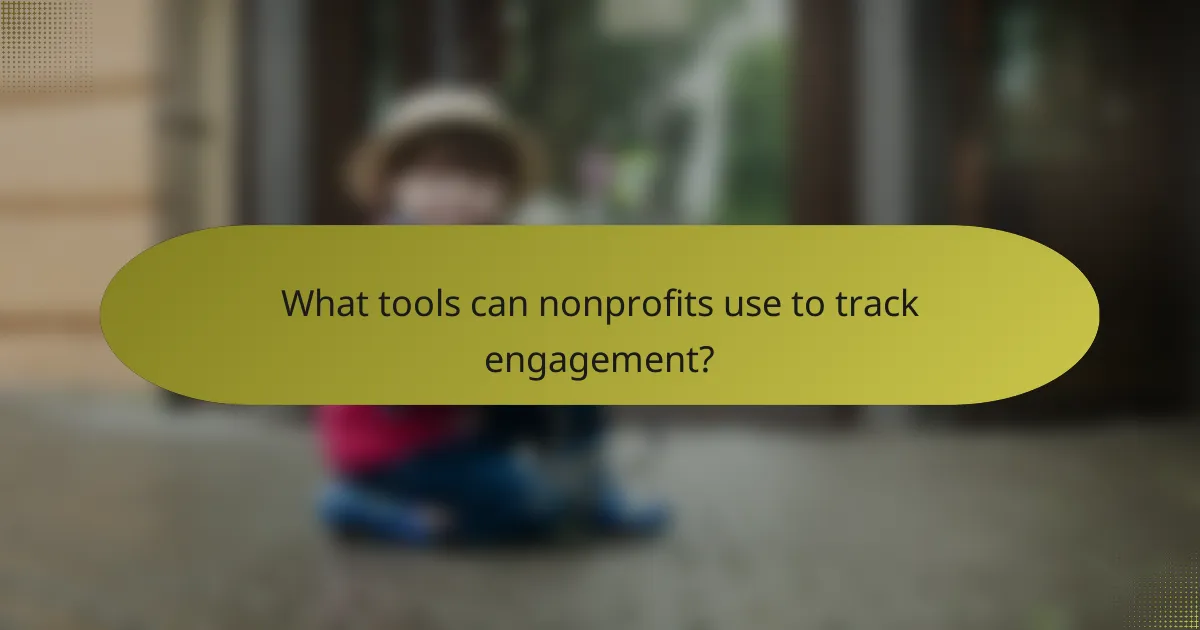
What tools can nonprofits use to track engagement?
Nonprofits can utilize various tools to effectively track engagement metrics across different platforms. These tools help organizations understand their audience’s behavior and improve their outreach efforts.
Google Analytics for website metrics
Google Analytics is a powerful tool for tracking website metrics, providing insights into user behavior, traffic sources, and engagement levels. Nonprofits can monitor key performance indicators such as page views, session duration, and bounce rates to assess the effectiveness of their online presence.
To get started, nonprofits should set up goals within Google Analytics to measure specific actions, like newsletter sign-ups or donations. Regularly reviewing these metrics can help organizations identify trends and optimize their websites for better user experience.
Hootsuite for social media management
Hootsuite is an effective platform for managing social media engagement, allowing nonprofits to schedule posts, track interactions, and analyze performance across multiple channels. It provides valuable metrics such as likes, shares, comments, and follower growth, which are essential for evaluating social media strategies.
Nonprofits should take advantage of Hootsuite’s reporting features to generate insights on what content resonates most with their audience. This can inform future campaigns and help organizations allocate resources more effectively.
Mailchimp for email performance
Mailchimp is widely used for email marketing and provides robust analytics to track email performance. Nonprofits can monitor open rates, click-through rates, and subscriber growth to gauge the effectiveness of their email campaigns.
To maximize engagement, nonprofits should segment their email lists and tailor content to different audience groups. Regularly testing subject lines and email formats can also enhance performance and increase donor engagement.
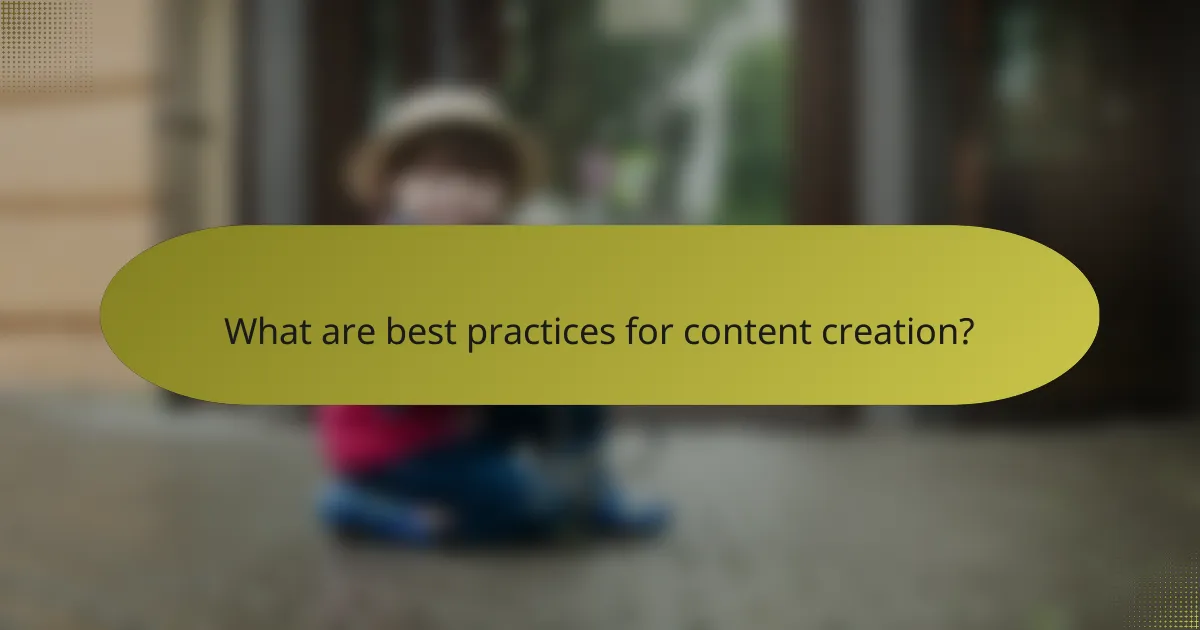
What are best practices for content creation?
Best practices for content creation involve understanding your audience, leveraging data insights, and using diverse media formats. These strategies enhance engagement and effectiveness for nonprofits aiming to communicate their mission and impact.
Focus on audience-centric storytelling
Audience-centric storytelling means crafting narratives that resonate with your target demographic. Start by identifying the values and interests of your audience, then weave these elements into your stories to create emotional connections.
Utilize testimonials and case studies to illustrate your impact. For instance, sharing a volunteer’s journey or a beneficiary’s success can make your message more relatable and compelling.
Use data-driven insights for topics
Data-driven insights help you select relevant topics that align with audience interests and current trends. Analyze engagement metrics from previous content to identify what resonates most with your audience.
Consider using surveys or social media polls to gather direct feedback on topics your audience cares about. This approach ensures your content remains relevant and engaging, ultimately driving higher engagement rates.
Incorporate multimedia elements
Incorporating multimedia elements, such as images, videos, and infographics, can significantly enhance content engagement. Visuals break up text and make information more digestible, appealing to various learning styles.
For example, a short video highlighting a recent event or an infographic summarizing key statistics can effectively convey your message. Aim for a mix of formats to keep your content fresh and engaging.
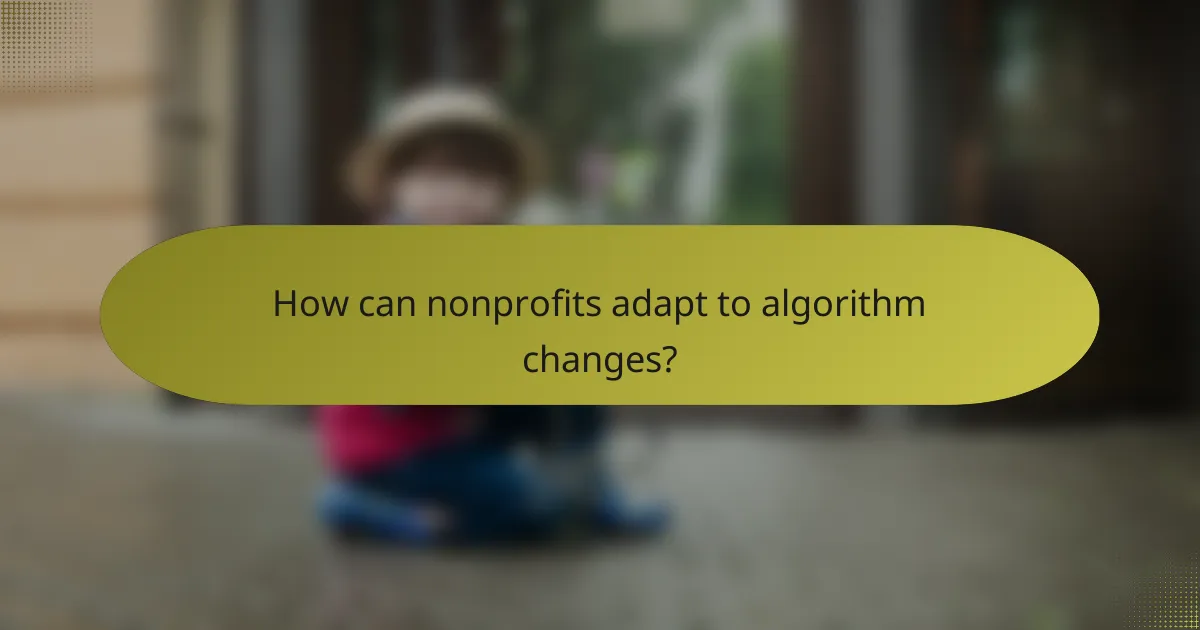
How can nonprofits adapt to algorithm changes?
Nonprofits can adapt to algorithm changes by staying informed about the latest trends and adjusting their strategies accordingly. This involves understanding how algorithms prioritize content and engaging with their audience in meaningful ways.
Understanding algorithm priorities
Algorithms prioritize content based on user engagement, relevance, and timeliness. For nonprofits, this means creating content that resonates with their audience’s interests and encourages interaction, such as likes, shares, and comments. Regularly reviewing engagement metrics can help identify what types of content perform best.
Consider using tools like Google Analytics or social media insights to track which posts generate the most engagement. This data can guide future content creation and help nonprofits align their messaging with audience preferences.
Creating engaging content
To create engaging content, nonprofits should focus on storytelling, visuals, and calls to action. Sharing compelling stories about their mission and impact can foster emotional connections with supporters. Incorporating high-quality images or videos can further enhance engagement.
Additionally, clear calls to action, such as encouraging donations or volunteer sign-ups, can drive user interaction. Experimenting with different formats, like live videos or infographics, can also help capture attention and maintain interest.
Monitoring and adapting strategies
Regularly monitoring engagement metrics is crucial for adapting strategies effectively. Nonprofits should analyze which content types yield the best results and adjust their approaches based on these insights. This may involve shifting focus to more popular topics or experimenting with new platforms.
Establishing a feedback loop with supporters can also provide valuable insights. Surveys or direct outreach can help nonprofits understand their audience’s needs and preferences, allowing for more tailored content that aligns with algorithmic changes.





